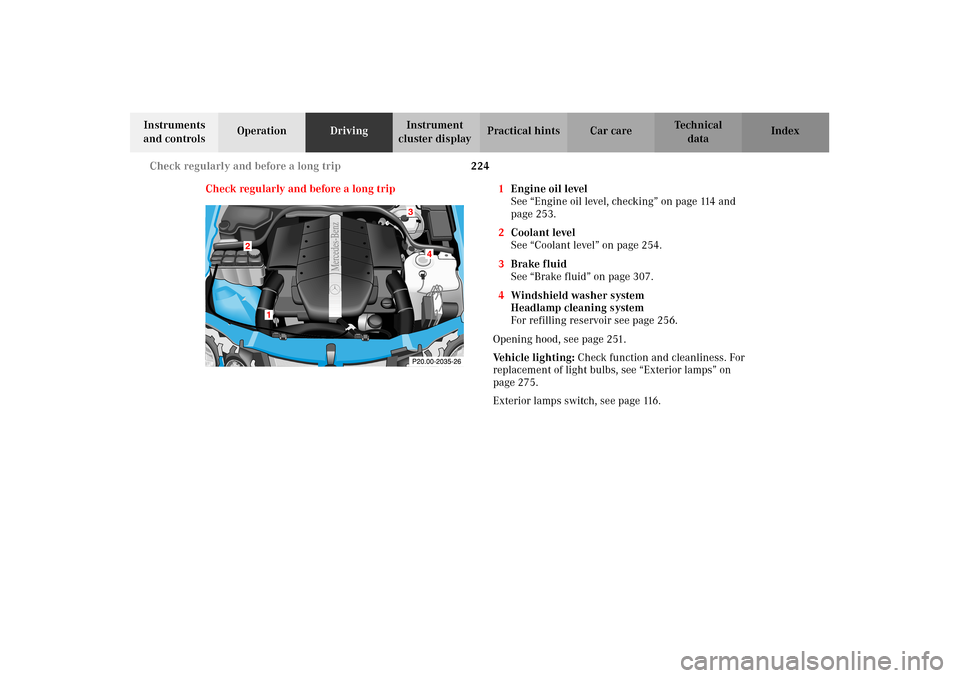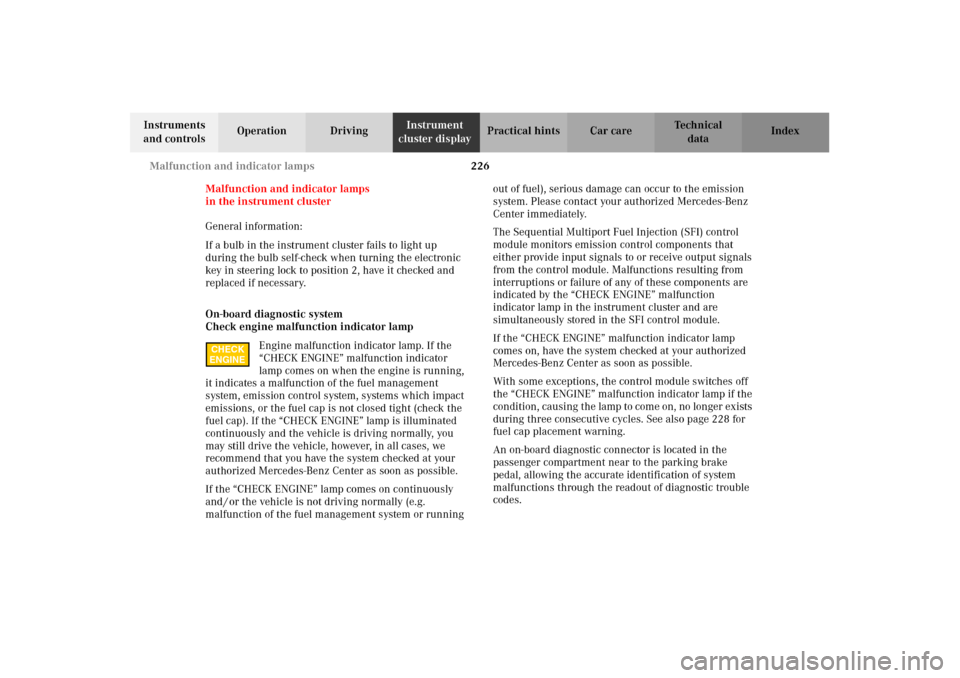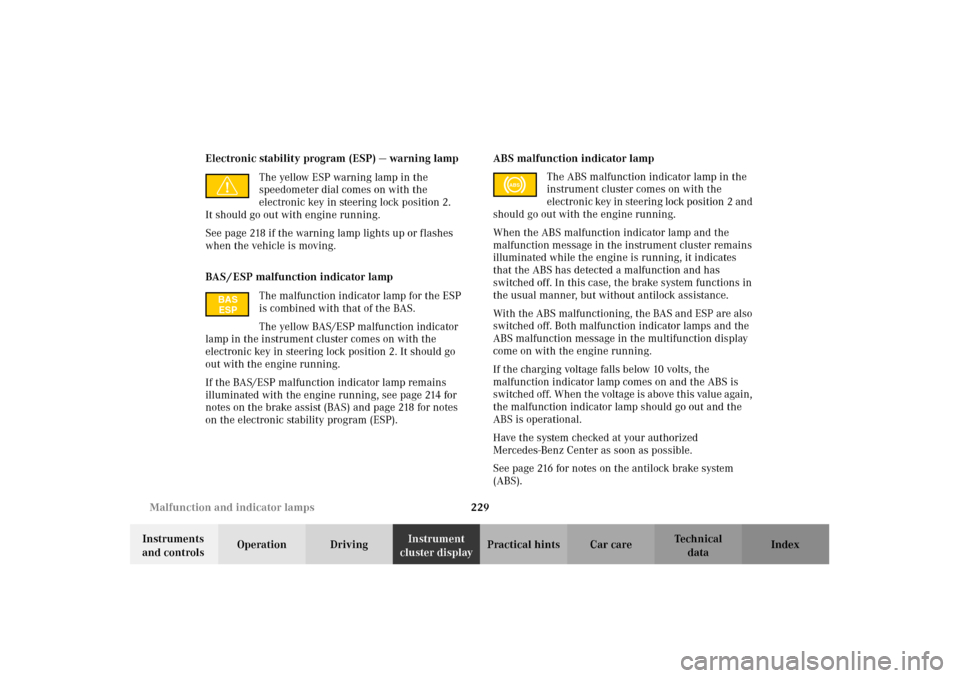2002 MERCEDES-BENZ CLK430 check engine light
[x] Cancel search: check engine lightPage 7 of 330

4 Contents
Malfunction and
indicator lamps in the
center console ........................... 231
AIRBAG OFF indicator lamp ..... 231
Malfunction and
warning messages in the
multifunction display ...............232
DISPLAY DEFECTIVE
(engine control unit) ..................233
DISPLAY DEFECTIVE
(several systems) ........................233
BATTERY/ALTERNATOR ...........234
ABS-SYSTEM ...............................235
BRAKE ASSIST ...........................235
BRAKE LINING WEAR ..............236
BRAKE FLUID .............................236
PARKING BRAKE .......................237
ENGINE FAN ...............................237
COOLANT
(coolant level) .............................238
COOLANT TEMP.
(coolant temperature) ................239
LIGHTING SYSTEM ....................240
LIGHT SENSOR ........................... 241STEER. WHEEL ADJUST. .......... 241
ENGINE OIL LEVEL ................... 242
ELEC. STABIL. PROGRAM.
(Electronic stability
program) ..................................... 243
REMOVE KEY ............................. 243
WASHER FLUID ......................... 244
TELE AID ..................................... 245
Practical hintsFirst aid kit ..................................... 248
Shelf below rear window .............. 248
Stowing things in
the vehicle ................................. 248
Fuses ............................................... 249
Hood ................................................ 251
Checking engine oil level ............. 253
Automatic transmission
fluid level ................................... 254
Coolant level ................................... 254
Adding coolant ........................... 255
Windshield washer / headlamp
cleaning system ........................ 256Windshield and headlamp
washer fluid mixing ratio .........256
Spare wheel, vehicle tools,
storage compartment ................257
Vehicle jack .....................................258
Wheels .............................................259
Tire replacement ........................259
Rotating wheels ..........................260
Spare wheel .................................... 261
Changing wheels ...........................262
Tire inflation pressure ..................267
Battery .............................................268
Jump starting ..................................270
Towing the vehicle .........................272
Transmission selector lever,
manually unlocking ................... 274
Exterior lamps ................................275
Headlamp assembly ................... 276
Taillamp assemblies ..................278
Adjusting headlamp aim ...............280
Changing batteries in
the electronic key .....................283
Synchronizing remote
control ..........................................285
J_C208_II.book Seite 4 Donnerstag, 31. Mai 2001 10:13 10
Page 29 of 330

26 Central locking system
Technical
data Instruments
and controlsOperationDrivingInstrument
cluster displayPractical hints Car care Index
Start lock-out
Important!
Removing the electronic key from the steering lock
activates the start lock-out. The engine cannot be
started.
Inserting the electronic key in the steering lock
deactivates the start lock-out.
Note:
In case the engine cannot be started (vehicle’s battery is
in order), the system is not operational. Contact an
authorized Mercedes-Benz Center or call 1-800-FOR-
MERCedes (in the USA) or 1-800-387-0100 (in Canada).General notes on the central locking system
If the electronic key is inserted in the steering lock, the
vehicle cannot be locked or unlocked with the remote
control.
If the vehicle cannot be locked or unlocked:
•Aim transmitter eye at a receiver of either door
handle. Check the batteries of the electronic key, see
page 283 or to synchronize the remote control, see
page 285.
•Use the mechanical key to unlock the driver’s door.
To start the engine, insert the electronic key in the
steering lock. There could be a slight delay until the
electronic key can be turned in the steering lock.
Important!
When unlocking the driver’s door with the mechanical
key, the exterior lamps will flash and the alarm will
sound.
To cancel the alarm, insert the electronic key in the
steering lock or press buttonŒ or‹ on the
electronic key.
J_C208_II.book Seite 26 Donnerstag, 31. Mai 2001 10:13 10
Page 207 of 330

204 Driving instructions
Technical
data Instruments
and controlsOperationDrivingInstrument
cluster displayPractical hints Car care Index
Power assistance
BrakesExcessive use of salt and other snow melting chemicals
spread on roads during the winter months may cause a
build up of moisture or residue to form on the braking
components. This build up or residue could cause light
corrosion of the braking components if the vehicle is
parked with the brakes cold. Apply steady and even
braking pressure when stopping the vehicle to warm up
and dry the brake components.
Important!
Please pay attention to the function of the brake assist
system (BAS), see page 214.
The condition of the parking brake system is checked
each time the vehicle is in the shop for the required
maintenance service at an authorized Mercedes-Benz
Center.
If the parking brake is released and the brake warning
lamp in the instrument cluster stays on, the brake fluid
level in the reservoir is too low.
Brake pad wear or a leak in the system may be the
reason for low brake fluid in the reservoir.
Have the brake system inspected at an authorized
Mercedes-Benz Center immediately.
Wa r n i n g !
When the engine is not running, the brake and
steering systems are without power assistance.
Under these circumstances, a much greater effort is
necessary to stop or steer the vehicle.Wa r n i n g !
After driving in heavy rain for some time without
applying the brakes or through water deep enough
to wet brake components or salty road conditions,
the first braking action may be somewhat reduced
and increased pedal pressure may be necessary to
obtain expected braking effect. Be sure to maintain
a safe distance from vehicles in front.Resting your foot on the brake pedal will cause
excessive and premature wear of the brake pads.It can also result in the brakes overheating thereby
significantly reducing their effectiveness. It may
not be possible to stop the vehicle in sufficient time
to avoid an accident.
J_C208_II.book Seite 204 Donnerstag, 31. Mai 2001 10:13 10
Page 227 of 330

224 Check regularly and before a long trip
Technical
data Instruments
and controlsOperationDrivingInstrument
cluster displayPractical hints Car care Index
Check regularly and before a long trip 1Engine oil level
See “Engine oil level, checking” on page 114 and
page 253.
2Coolant level
See “Coolant level” on page 254.
3Brake fluid
See “Brake fluid” on page 307.
4Windshield washer system
Headlamp cleaning system
For refilling reservoir see page 256.
Opening hood, see page 251.
Ve h i c l e l i g h t i n g : Check function and cleanliness. For
replacement of light bulbs, see “Exterior lamps” on
page 275.
Exterior lamps switch, see page 116.
Mercedes-Benz
Mercedes-Benz
4
2
1
3
J_C208_II.book Seite 224 Donnerstag, 31. Mai 2001 10:13 10
Page 228 of 330

225 Contents – Instrument cluster display
Technical
data Instruments
and controlsOperation DrivingInstrument
cluster displayPractical hints Car care Index
Instrument cluster displayMalfunction and
indicator lamps in the
instrument cluster ....................226
On-board diagnostic system
Check engine malfunction
indicator lamp .............................226
Brake warning lamp ..................227
Supplemental restraint system
(SRS) indicator lamp ..................228
Fuel reserve and fuel cap
placement warning ....................228
Electronic stability program
(ESP) — warning lamp ...............229
BAS/ESP malfunction
indicator lamp .............................229
ABS malfunction
indicator lamp .............................229
Telescoping steering column –
indicator lamp .............................230
Seat belt warning lamp .............230Malfunction and
indicator lamps in the
center console ........................... 231
AIRBAG OFF indicator lamp .... 231
Malfunction and
warning messages in the
multifunction display .............. 232
DISPLAY DEFECTIVE
(engine control unit) ................. 233
DISPLAY DEFECTIVE
(several systems) ....................... 233
BATTERY/ALTERNATOR .......... 234
ABS-SYSTEM .............................. 235
BRAKE ASSIST ........................... 235
BRAKE LINING WEAR .............. 236
BRAKE FLUID ............................ 236
PARKING BRAKE ....................... 237
ENGINE FAN ............................... 237
COOLANT
(coolant level) ............................. 238
COOLANT TEMP.
(coolant temperature) ............... 239LIGHTING SYSTEM ....................240
LIGHT SENSOR ........................... 241
STEER. WHEEL ADJUST. ........... 241
ENGINE OIL LEVEL ...................242
ELEC. STABIL. PROGRAM.
(Electronic stability
program) ......................................243
REMOVE KEY .............................243
WASHER FLUID .........................244
TELE AID .....................................245
J_C208_II.book Seite 225 Donnerstag, 31. Mai 2001 10:13 10
Page 229 of 330

226 Malfunction and indicator lamps
Technical
data Instruments
and controlsOperation DrivingInstrument
cluster displayPractical hints Car care Index
Malfunction and indicator lamps
in the instrument cluster
General information:
If a bulb in the instrument cluster fails to light up
during the bulb self-check when turning the electronic
key in steering lock to position 2, have it checked and
replaced if necessary.
On-board diagnostic system
Check engine malfunction indicator lamp
Engine malfunction indicator lamp. If the
“CHECK ENGINE” malfunction indicator
lamp comes on when the engine is running,
it indicates a malfunction of the fuel management
system, emission control system, systems which impact
emissions, or the fuel cap is not closed tight (check the
fuel cap). If the “CHECK ENGINE” lamp is illuminated
continuously and the vehicle is driving normally, you
may still drive the vehicle, however, in all cases, we
recommend that you have the system checked at your
authorized Mercedes-Benz Center as soon as possible.
If the “CHECK ENGINE” lamp comes on continuously
and / or the vehicle is not driving normally (e.g.
malfunction of the fuel management system or running out of fuel), serious damage can occur to the emission
system. Please contact your authorized Mercedes-Benz
Center immediately.
The Sequential Multiport Fuel Injection (SFI) control
module monitors emission control components that
either provide input signals to or receive output signals
from the control module. Malfunctions resulting from
interruptions or failure of any of these components are
indicated by the “CHECK ENGINE” malfunction
indicator lamp in the instrument cluster and are
simultaneously stored in the SFI control module.
If the “CHECK ENGINE” malfunction indicator lamp
comes on, have the system checked at your authorized
Mercedes-Benz Center as soon as possible.
With some exceptions, the control module switches off
the “CHECK ENGINE” malfunction indicator lamp if the
condition, causing the lamp to come on, no longer exists
during three consecutive cycles. See also page 228 for
fuel cap placement warning.
An on-board diagnostic connector is located in the
passenger compartment near to the parking brake
pedal, allowing the accurate identification of system
malfunctions through the readout of diagnostic trouble
codes.
CHECK
ENGINE
J_C208_II.book Seite 226 Donnerstag, 31. Mai 2001 10:13 10
Page 232 of 330

229 Malfunction and indicator lamps
Technical
data Instruments
and controlsOperation DrivingInstrument
cluster displayPractical hints Car care Index Electronic stability program (ESP) — warning lamp
The yellow ESP warning lamp in the
speedometer dial comes on with the
electronic key in steering lock position 2.
It should go out with engine running.
See page 218 if the warning lamp lights up or flashes
when the vehicle is moving.
BAS / ESP malfunction indicator lamp
The malfunction indicator lamp for the ESP
is combined with that of the BAS.
The yellow BAS/ESP malfunction indicator
lamp in the instrument cluster comes on with the
electronic key in steering lock position 2. It should go
out with the engine running.
If the BAS/ESP malfunction indicator lamp remains
illuminated with the engine running, see page 214 for
notes on the brake assist (BAS) and page 218 for notes
on the electronic stability program (ESP).ABS malfunction indicator lamp
The ABS malfunction indicator lamp in the
instrument cluster comes on with the
electronic key in steering lock position 2 and
should go out with the engine running.
When the ABS malfunction indicator lamp and the
malfunction message in the instrument cluster remains
illuminated while the engine is running, it indicates
that the ABS has detected a malfunction and has
switched off. In this case, the brake system functions in
the usual manner, but without antilock assistance.
With the ABS malfunctioning, the BAS and ESP are also
switched off. Both malfunction indicator lamps and the
ABS malfunction message in the multifunction display
come on with the engine running.
If the charging voltage falls below 10 volts, the
malfunction indicator lamp comes on and the ABS is
switched off. When the voltage is above this value again,
the malfunction indicator lamp should go out and the
ABS is operational.
Have the system checked at your authorized
Mercedes-Benz Center as soon as possible.
See page 216 for notes on the antilock brake system
(ABS).
BAS
ESP
ABS
J_C208_II.book Seite 229 Donnerstag, 31. Mai 2001 10:13 10
Page 243 of 330

240 Malfunction and warning messages
Technical
data Instruments
and controlsOperation DrivingInstrument
cluster displayPractical hints Car care Index
LIGHTING SYSTEMWhen the message appears after starting the engine, or
if it comes on while driving, this indicates a failure in
the parking lamp, taillamp, stop lamp, or low beam
headlamp. See page 275 for instructions on replacing
bulbs.
If an exterior lamp fails, the message will appear only
when that lamp is switched on.
If a brake lamp fails, the message will appear when
applying the brake and stays on until the engine is
turned off.
Note:
If additional lighting is installed (e.g. auxiliary
headlamps etc.) be certain to connect into the fuse
before the failure indicator monitoring unit order to
avoid damaging the system.
Line 1 Line 2
LAMP DEFECTIVE CHECK LAMPS!
DISPLAY DEFECTIVE VISIT WORKSHOP!
J_C208_II.book Seite 240 Donnerstag, 31. Mai 2001 10:13 10